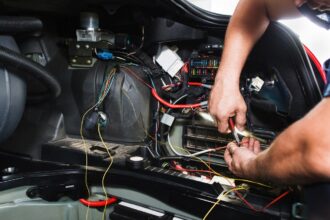An air conditioner usually has different critical components that function together to achieve efficiency. One of these essential components is the thermistor. This small temperature-sensitive resistor manages the cooling process through temperature readings sent to the control board of the air conditioner. When this minuscule yet vital accessory goes out of order, the result will be an irregular cooling or even total system malfunctioning. In such cases, one would think of replacing the broken thermistor. Replacing a faulty thermistor is a relatively easy process, bringing back the effective working of the air conditioning system. Visit https://www.socool.sg/aircon-thermistor-replacement/ to learn more about how thermistors work.
What Is A Thermistor in An Air Conditioning Unit
Thermistors play the most important role in controlling the periodic intervals of cooling cycles of an air conditioner. It detects any temperature variation and adjusts the operations of not only the compressor but also the fan. When the temperature of the air hits a point higher than the set value, it tends to turn on the cooling cycle through the control signal sent to the control board. For example, it signals slowing down or even stopping when the air temperature hits the specific level desired. This results in energy efficiency and assures maximum comfort. Visit https://www.socool.sg/ to hire trained professionals for thermistor replacement.
Erroneous temperature readings are one of the signs of a faulty thermistor that can cause the air conditioner to overcool, undercool, or even cycle erratically, without even turning on in severe cases causing discomfort and increased energy consumption.
Steps for Thermistor Replacement in Air Conditioners
Some basic tools and knowledge of the air conditioning system are required for thermistor replacement. Following are the steps to follow in order to replace the faulty component safely and effectively:
Turn Off the Power: Electrical hazards could set in, and in doing any repairs whatsoever, it is always good practice to turn off the air conditioner.
Access the Thermistor: The thermistor can be found in the air conditioning unit. It is generally attached to the evaporator coil or near the control board. The specification for placement can be referenced in the aircon’s user manual.
Remove the Faulty Thermistor: Remove the thermistor by detaching it from the housing and wiring carefully. Some thermistors have clips onto the evaporator coil, while others may be fixed with screws.
Install the New Thermistor: The new thermistor should be installed and secured into place correctly with proper alignment. The wiring must be connected correctly to avoid malfunctions.
Reassemble the Unit: After the new thermistor is installed, all the covers or panels removed during the process should be put back.
Restore Power and Test: It is time to turn on the power and check that the air conditioner is maintaining the right temperature and operating smoothly.
Tips for Successful Thermistor Replacement
The thermistor chosen must always be the same as the one installed in the air conditioning unit; otherwise, it will not work. Generally, clean and properly maintained aircon units allow for the longer lifespan of all components, including thermistors.
Conclusion
A thermistor is an important part of air conditioning system for efficient cooling and energy conservation. Any problem with thermistor creates panic-like behavior in the air conditioner and severely affects the comfort and efficiency of the system. Understanding failure symptoms and methodically replacing thermistor will aid in achieving expected operation of an air conditioner. Continued maintenance and repairs, on the other hand, can increase life span of the unit as a whole and ensure that cool air is there in the home or office at all times.

















